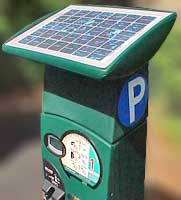"Managing" Parking still an issue
 Solar powered parking meter kiosk.
Solar powered parking meter kiosk.Because Mayor Williams has suspended for four months the ongoing parking "negotiations" between residents and churches in the Logan Circle neighborhood (among other places)neighborhood e-lists are still discussing this issue. Given the fear of politicos about church sermons given this is an election year, it's no surprise that City Councilmembers have eagerly acquiesced, although some of the citizens who have been working on this diligently for months feel sandbagged.
(Note that I don't have a problem with church parking on Sundays, but I do think it should be managed through required "Transportation Demand Management" programs and there should be a form of "valet" parking so that residents aren't unduly inconvenienced.)
Anyway, one of the threads reminded me of an article I meant to call your attention to, from Seattle Weekly, "Parking Sticker Shock: Pay stations are so lucrative, the city is expanding their use to areas that were once free. Paid street parking in the evening could be next." From the article:
The program to replace parking meters on city streets with a pay- station system is a financial success no one at City Hall wants to brag about. New figures show the ubiquitous curbside kiosks, which issue time-stamped parking stickers that can be affixed to a car window, are already earning about $3 more a day per parking space—at $6.50, they're bringing in almost twice as much as the clunky coin meters they replaced. The wireless, solar-powered kiosks will collect $16 million in coin and credit- or debit-card revenue this year, officials say. That's an impressive $6 million jump since 2003, when the system was launched and parking meters collected $9.9 million.
Being a government program, there's a catch, of course, which might be why politicos and bureaucrats don't seem to be talking up the big score. A great deal of the added revenue is coming from hundreds of pay stations that have been or will be installed at once-free downtown and neighborhood parking spaces. The target is the citywide conversion of 2,000 free or time-limited parking spaces (30-minute and two-hour spots, for example) to paid kiosk spaces.
________
DC uses the same basic system, although I don't think it is solar-powered. There is nothing to prevent the City from thinking more expansively about making parking pay its way.
Also see this Washington Times article from 2005, "District doubles parking tickets," for information on ticket revenue (and increased productivity amongst DPW staffers).
Index Keywords: parking



0 Comments:
Post a Comment
<< Home